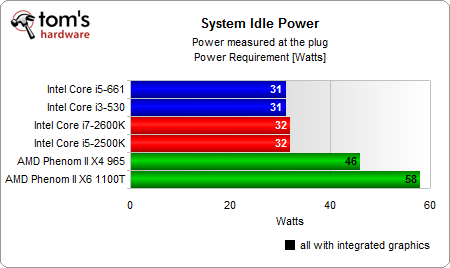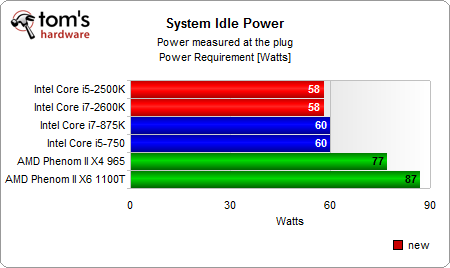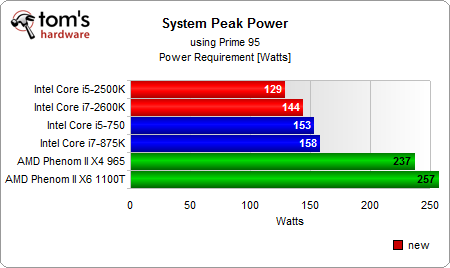Efficiency Comparison: Sandy Bridge Vs. Intel And AMD CPUs
The second-generation Core processors arrived with a bang, but what sort of progress can you expect in the performance per watt department? We compare Core i5/i7-2x00 to AMD's Phenom with four and six cores, as well as previous-gen parts from Intel.
Power Consumption Results
Integrated Graphics Power Consumption
System idle power on the integrated graphics systems is almost identical if you compare Intel’s current Core i3/i5 with the new Sandy Bridge generation. The difference we measured at the plug was only 1 W. But keep in mind that both of the new Core i5 and i7 processors are based on four processing cores, while the Core i5-661 and Core i3-530 only offer two physical cores. We find it significant that the AMD systems require 50% more idle power in case of the Phenom II X4 and most than 90% higher idle power on the Phenom II X6. Remember: this is without being faster in most of the workloads.
You could argue that AMD power consumption can be decreased by using lower-power processors. However, this would also be the case on the Intel side. After all, there are S- and T-class Sandy Bridge-based parts. Overall, there is no arguing about this massive difference in idle power consumption.
The peak power consumption readings are interesting as well. Keep in mind that we’re talking about CPUs with integrated graphics here. However, the load only applies to the CPU cores.
The Clarkdale-based Core i3/i5 chips go up to 82 and 89 W at the plug, which is a rather good result for an office PC. However, the Sandy Bridge platforms don’t reach significantly higher power consumption (114 W for the Core i5 with four cores and 6 MB cache or 136 W for the Core i7 with 8 MB cache and slightly more clock speed). Both AMD platforms require way more power.
Discrete Graphics Power Consumption
Obviously, adding a graphics card increases system idle power. This is the case across the board, as you can see a pretty straight increase on all systems: it’s an addition of roughly 30 W compared to the power consumption from an integrated platform. Keep in mind that the numbers here now show Intel's LGA 1156-based Lynnfield processors, whereas the integrated LGA 1156 systems employ Clarkdales.
Get Tom's Hardware's best news and in-depth reviews, straight to your inbox.
The peak power consumption numbers are interesting, though, as they show the difference between Intel’s 45 nm processors and the new 32 nm generation of quad-core chips. Peak CPU power is lower on Sandy Bridge despite clearly improved performance. This is promising for the efficiency evaluation.
Current page: Power Consumption Results
Prev Page Benchmark Results: Discrete Graphics Performance Next Page Integrated Graphics Efficiency Results


